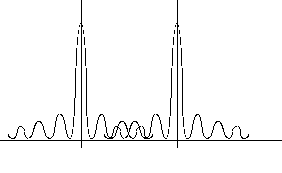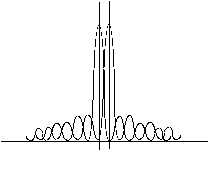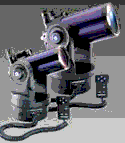

Optical Resolution
If we look closely enough, every image is surrounded by a diffraction pattern produced by the wave nature of light as it passes through an opening like the edge of a lens.
The diffraction pattern produced by a circular opening is very similar to that produced by a single slit.
For a slit, the angular distance from the center of the central maximum to the first minimum is
.
For a circular opening, the angular distance from the center of the central maximum to the first minimum is

If we look at two stars that have a large angular separation, their diffraction patterns hardly overlap, and we clearly distinguish that there are two stars.
The same would be true of two items of cell structure when viewed through a microscope.

As the two objects come closer, their diffraction patterns overlap and it may become difficult to distinguish the two images.

"Rayleigh's criterion" for the resolution of two point sources is that the first minimum of one diffraction pattern occurs at the central maximum of the other one.
Untrained eyes will loose distinction before this and well trained eyes may distinguish two sources even closer than Rayleigh's criterion.

Telescopes that meet this criterion -- called Raleigh's criterion -- are called "diffraction limited". They can not be improved. They are at the limit -- because of the wave nature of light.
ETX-90EC Astro Telescope: For the casual or beginning observer the Meade ETX-90EC may be all the telescope ever required. Or, for the advanced astronomer who already owns a larger instrument, the ETX-90EC is the perfect ultraportable, diffraction-limited field telescope. Observe the continually changing cloud-belt patterns on the surface of the planet Jupiter; shadows cast on to Jupiter as one of its four principal satellites transits the planet's disc; the magnificent ring system and satellites of Saturn as well as dusky markings and the ring-shadow on the surface of Saturn; Moon craters by the hundred, plus lunar rilles,
(c) Doug Davis, 2002; all rights reserved
Return to Ch 20, Wave Optics: Interference and Diffraction